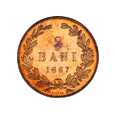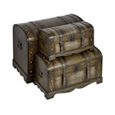THE RHYTON FROM POROINA MARE
Text: Alexandru Arbunescu / Photo: Marius Amarie
OBJECT DESCRIPTION
The rhyton from Poroina Mare is a partially gilded, silver horn-shaped object, which ends in a bull-shaped protome. The gilded fluting is slightly bent towards the exterior and is adorned with a narrow band decorated with incised diagonal lines and a row of double ovolos with a dot inside. On the neck of the vessel, a religious scene depicting four women is represented in the repoussé technique: two of them are sitting down face-to-face on a stool, either of them holding a rhyton embedded with ribs placed in oblong ovolos in one hand and a phial with an umbo in the other and the other two are standing with the right hand raised. The hair, portrayed in the same manner for all the four of them, frames their faces, falling on the shoulders of the seated ones. As for the other ones, it seems to be pulled back. The barefoot characters with bare arms are wearing a long robe down to their ankles, a sort of a chiton, which has drapes decorated with dots. The seated ones appear to be wearing a himation tied up in a knot over that garment. The hair and the clothing are gilded.
The female characters are depicted in a harsh manner, emphasizing the lack of a concept of the perspective in space. Unlike the artless manner and the primitive technique in which the female characters are created, the bull-shaped protome is executed using a superior artistic technique and manner. The ears are missing and the circumstances in which they were removed are unknown. The hair on the bull’s gilded forehead is made of large regular curls, on both sides of one highlighted central line. The area between the muzzle and the eyes is bounded by an embossed gilded line. A crossline is deeply incised between the places where the horns should have been. In the middle of the forehead, between the eyes, a swirl with a dot in the center is rendered. The quasi-oval shaped eyes, portrayed in a very vivid and expressive manner, appear to have been covered in a colored paste, which is not noticeable anymore. The eyelids with three deep creases and the curled hair under the eyes are gilded. One embossed gilded line starts form the corners of the eyes and goes below the chin. The gilded hair beneath the chin is depicted by two groups of horizontal wavy lines separated by a median line. The upper part of the muzzle is decorated with two distant dotted lines. Beneath the muzzle, there is a hole for the fluid drainage.
The piece has the height of 16.00 cm, the maximum outer diameter at the vessel mouth is of 9.58 cm, the maximum inner diameter at the vessel mouth is of 8.66 cm, the width of the silver sheet is of 0.9 mm. and it weighs 279.42 g. As a result of the analysis of the object using the X-rays fluorescence spectrometer within The Department of Physicochemical and Biological Investigation of the National History Museum of Romania, the following components of the silver alloy, of which the rhyton is made, have been revealed: Ag-99,44%; Au-6,19% (on the gilded area); Fe-0,001%; Ni-0,001%; Cu-0,10%; Zn-0,16%; Pb-0,02% and Bi-0,001%.
THE HISTORY OF THE DISCOVERY
As a religious object used in religious rituals, this type of horn-shaped libation vessel with a zoomorphic protome at the lower end and provided with a second opening for fluid drainage, initially originates in the Mediterranean world, in the third millennium B.C. and then in the Hittite art during the 14th-13th Centuries B.C. Later, the rhyton, which was wide-spread in the Persian world and frequently encountered in Greek toreutics as far back as the 5th Century B.C., was also acquired in the Thracian-Getae art during the 4th- 3rd Century B.C. The partially gilded silver rhyton from Poroina Mare, Mehedinţi County, was accidentally discovered and it entered the collection of the former National Museum of Antiquities in 1883. In 1917, it was evacuate from the Museum along with the rest of the country’s treasure and taken to Russia. In 1956, the U.S.S.R handed the piece back to Romania, along with the treasure from Pietroasa and other objects with historical and archaeological value. At present, it belongs to the patrimony of the National History Museum of Romania.
The piece was mentioned for the first time by Al. Odobescu in his study “Le trésor de Pétrossa”, in which he fully described the rhyton, without approaching the problem of the dating or ethnic assignment, inferring, however, that it could be a product of the local art. In the study “Iranians and Greeks”, published in 1922, M. Rostovtzev considers that the piece dates back to the beginning of the 3rd century B.C. and that it belonged to the Sarmatians. In his study “Getica. O protoistorie a Daciei”, published in 1926, V.Pârvan agrees with the dating suggested by M. Rostovtzev. However, he assigns the piece to Scythians, arguing that, in those times, the Sarmatians were very far to the East. I. Nestor, in his study “Der stand der Vorgeschichtforschung in Rumänien”, published in 1933 and then D. Berciu, in “The Prehistoric Archeology of Oltenia”, published in 1939, consider the rhyton to be a product of Scythian art. Ecaterina Dunăreanu-Vulpe dates the piece around the year 100 B.C. in her work “Studies on the Romanian Treasure Returned by the U.S.S.R”, published in 1958. In his study “Thraco-Getae Art”, published in 1969, D. Berciu dwells again on the issue of the origin and chronology of this piece. By taking into consideration the stylistic analogies to the objects found in the treasure from Agighiol and Craiova, as well as to the ones discovered at Panaghiurişte, in Bulgaria, he assigned the rhyton from Poroina Mare to the Thracian-Getae culture, dating the piece in the late 4th century B.C. Based on the same analogies, the dating of the rhyton in the late 4th century - the early 3rd century is argued by Mihai Gramatopol and Gabriel Iliescu in the article “The Rhyton from Poroina and its Significance”, published in the “Magazin istoric” magazine, no. 4/ April 1984.
STYLISTIC ANALOGIES
The dating in a later period and the attribution of the rhyton from Poroina Mare to the Sarmatians or to the Scythians, argued especially by the discrepancy between the peculiar depiction of the zoomorphic ornamentation and the handcraft level of human features and even considering the hypothesis that the rhyton would have been created by two distinct craftsmen, in two different epochs, are not valid anymore. The outstanding artistic style and manner in which the bull-shaped protome was rendered, as well as the analogies concerning the primitive execution of the anthropomorphous figures on the rhyton, similar to the local technique and, also, present on the pieces discovered at Cucuteni-Băiceni, Coţofeneşti, Agighiol or Craiova, obliges us to consider the rhyton as a product of the Thracian-Getae art from the late 4th Century B.C. up to the early 3rd Century B.C. The rosette placed on the forehead of the rhyton protome is entirely similar to the rosettes placed on some of the bull heads found in the treasure from Craiova.
The manner of rendering the hair on the bull’s forehead is specific to the Thracian-Getae gold work and it also appears in one of the zoomorphic representations depicted on a vessel found in the treasure from Agighiol. There is also a subtle similarity between the manner in which the eyes from the horse-shaped protome are rendered on the frontal plate, found in the treasure from Cucuteni-Băiceni and the execution of the bull’s eyes of the rhyton discovered at Poroina Mare. On the other hand, the dotted background, which adorns the clothing of the female characters depicted on the neck of the rhyton, is also found on the gold coif from Coţofeneşti, as well as on other pieces found in the inventory of the tomb from Agighiol.
The same primitive, clumsy, perspective-less technique of representing the figures on the neck of the rhyton is also specific for the depiction of the warrior with a rhyton in his hand, placed on the right cheek piece of the helmet from the Cucuteni-Băiceni treasure, the depiction of the horsemen on the cheek pieces and the nape protector of the helmet or the one of the horsemen and the character which holds a rhyton in his hands placed on one of the two greaves from the Agighiol treasure, as well as the depiction of the sacrifice scenes on the cheek pieces of the gold helmet from Coţofeneşti. We notice that there are some similarities between the manner in which the hairstyle of the female characters on the rhyton is rendered and the manner in which the hair of the characters depicted on the triangular fibulae-masks, found in the treasure from Coada Malului, Prahova County, and those depicted on the fibulae-phalerae from Herăstrău is portrayed. They suggest the existence of a connection between the period of the Thracian-Getae art and the one of the Getae-Dacian art.
From a chronological point of view, these pieces are closer to the ceramic rhyton with horse-shaped protome, discovered in 1986 at Piscu Crăsani, Ialomiţa County. The ceramic rhyton is likely to be a clay replica of a precious metal prototype, which dates back to the second half of the 1st Century B.C. The rhyton from Poroina Mare also shows subtle similarities to the pieces from the treasure found in Panaghiurişte, Bulgaria. In his study “Sur la date et l’origine de trésor de Panaguriste”, Iv. Venedikov dates the treasure back to the late 4th Century- early 3rd century and assigns it to a local Thracian aristocrat. The dotted décor also appears on the rhyton vessels with bull heads from Panaghiurişte. A scene is depicted on the rhyton with a goat-shaped protome, in which the goddess Hera, sitting on the throne between the god Apollo and the goddess Artemis with a bow, holds a libation vessel in her right hand, almost identical to the two rhytas held by the female characters rendered on the rhyton from Poroina.
Scenes with rhyta representations similar to the ones on the rhyton from Poroina Mare, in which two of the four women, namely the ones portrayed sitting on a chair, are holding a rhyton in one hand and a phial in the other one, a scene which is probably connected to a fertility and abundance rite or the representation of the goddess Hera holding the rhyton in her right hand on the vessel from Panaghiurişte, frequently appear in the Thracian-Getae art. A similar scene depicting a warrior sitting down on a four-legged chair and holding a rhyton in his hand, is also rendered on one of the greaves from the Agighiol treasure. Furthermore, a warrior sitting on a chair and holding a rhyton in his left arm and a phial in his right hand is represented on the right cheek piece of the gold helmet, discovered at Cucuteni-Băiceni. Taking into account the stylistic analogies and the typically local crafting technique, the artless manner of the artist and even the lack of the idea of space perspective, we are entitled to consider the rhyton from Poroina Mare to be a local product of the Thracian-Getae art, which was receiving the overlapping influences from the Greeks and the Scythians, created in an indigenous manner and dating back to the 4th-3rd Centuries B.C.
















